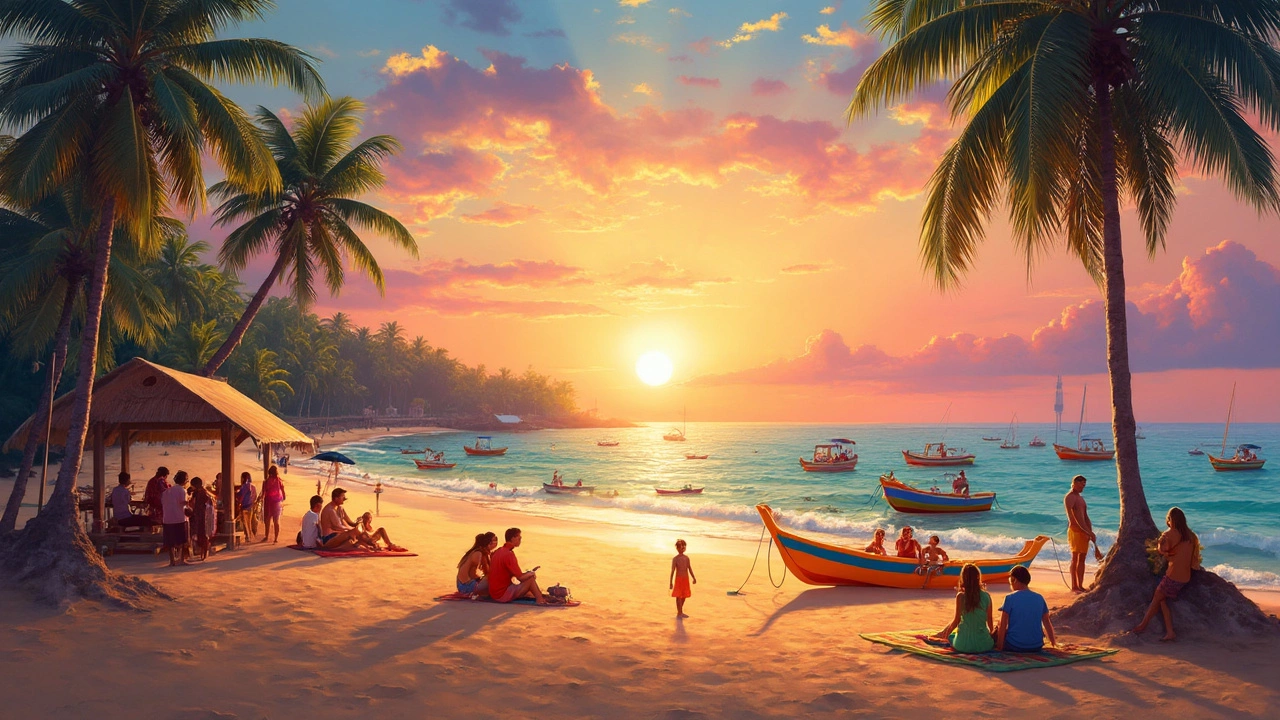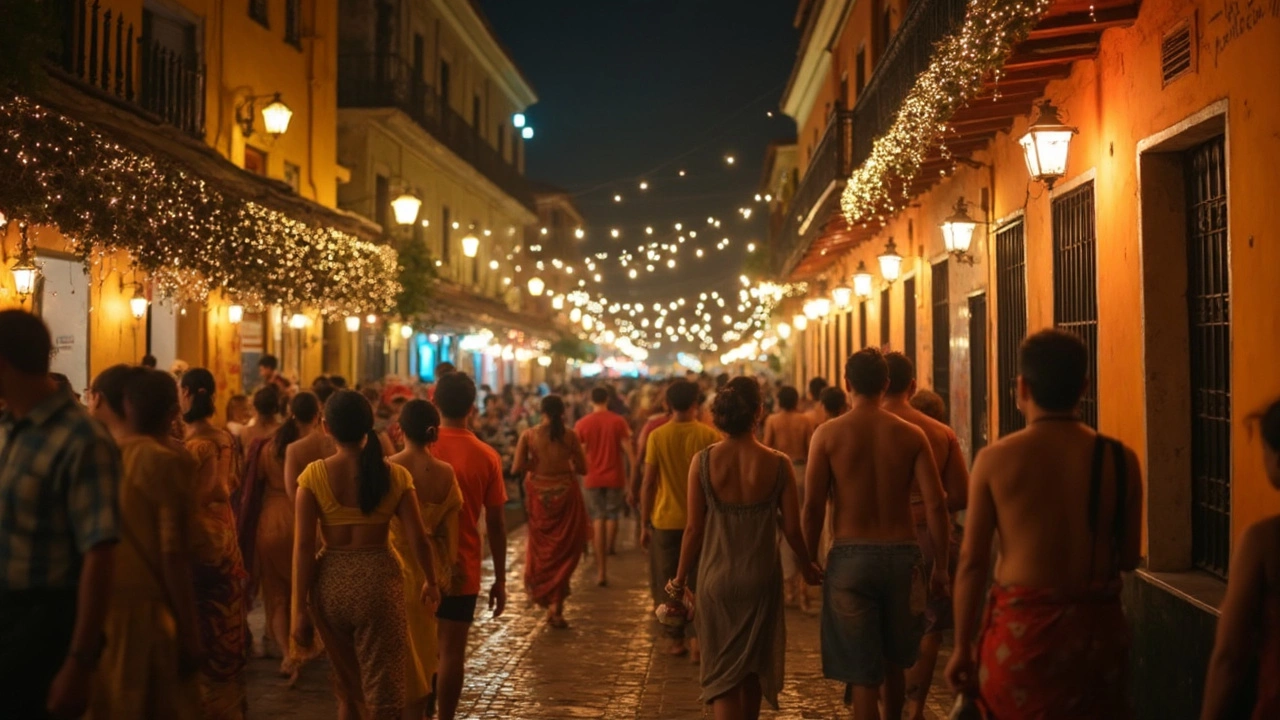Goa Tourism Guide: Discover India's Most Famous Beach Destination
 Jun, 28 2025
Jun, 28 2025
When you think of Indian beaches—those postcard-perfect stretches of golden sand with the Arabian Sea crashing in the background—one name pops up right away: Goa. But what makes this small state on India's west coast so legendary among travelers? It's not just another patch of sand. Goa packs an electric mix of sun-drenched shores, food that'll make you rethink seafood, and party scenes that have tempted even Bollywood stars to dance till sunrise. Yet, there's so much more beneath the surface, literally and figuratively. If you’re looking for the beach capital of India, Goa is the one that steals the crown, but it’s the stories, nooks, and local hacks that really make a visit memorable.
Why Goa? The Beaches That Built Its Reputation
Goa’s coastline runs over 100 kilometers, lined with more than 35 beaches—each with its own personality. Some buzz with beats, bonfires, and bodybuilders showing off; others are so low-key you might spot only a stray cow or a fisherman putting his net out at dawn. Let’s break down what makes each corner tick.
If you crave energy, head north. Places like Baga, Calangute, and Anjuna beach are Goa’s party magnets. Baga Beach alone reels in thousands every weekend, with shacks offering ice-cold Kingfisher beers and trance tracks that thump until sunrise. This is where you’ll get beach sports by day, fire dancers by night, and clubs like Titos and Mambo’s where the vibe is young and international. On Christmas and New Year’s Eve, the crowds double—so book your bed well in advance, because rooms fill up fast.
South Goa flips the story. Palolem, Agonda, and Colva are panoramic escapes if sunset yoga and beachcombing are your thing. Palolem’s curved crescent of sand looks straight out of a travel poster. You can rent a kayak, paddle out at sunrise, or just sit under swaying palms with a fresh coconut and your toes in the sand, far from any rush. Colva beach is longer but less wild—here, you’ll spot locals jogging at dawn, fishermen hauling in their daily catch, and families picnic-ing under makeshift tents.
Now, here’s a fun tidbit: the temperature in Goa rarely drops below 20°C—even in January. Water’s warm, the sun feels like a gentle hug, and even a rainy day (June to September) just means more dramatic clouds and that addictive scent of monsoon. That said, most plan their trips between November and March, avoiding the peak heat, humidity, and floods. If you prefer bargains and fewer crowds, show up at the edges of high season (late October or April)—prices drop by up to 40%, and the beach is practically yours.
| Beach | Vibe | Best Time to Visit | Nearby Attraction |
|---|---|---|---|
| Baga | Party, Water Sports | November to February | Saturday Night Market |
| Palolem | Chill, Scenic | October to March | Butterfly Beach |
| Agonda | Quiet, Relaxed | November to April | Cabo de Rama Fort |
| Colva | Family Friendly | November to February | Our Lady of Mercy Church |
| Anjuna | Bohemian, Flea Market | December to March | Wednesday Flea Market |
Not done yet: swimming is generally safe, but stick to areas patrolled by lifeguards (yellow-red flags mean safe zones). Be wary of strong undertows during monsoon, and always ask locals about the best spots if you’re thinking of surfing or snorkeling.
Goa Beyond Beaches: Food, Culture, and Nightlife
If you think Goa is just about sand and sea, hold onto your hat. The real trip starts on your plate and in its old Portuguese lanes. Goa’s food is an explosion of spice, coconut, fresh seafood, and sometimes, more chili than you bargained for—vindaloo, xacuti, and fish-curry-rice (a classic Goa combo) find fans across the world now. The secret? Centuries of blending Indian and Portuguese recipes, plus local ingredients plucked straight from the sea or a spice farm up the road.
Ask around for a shack called Souza Lobo in Calangute or Fisherman’s Wharf in South Goa—locals swear by their prawn curry and kingfish rava fry. But, the adventure lies in trying something offbeat: maybe an urak cocktail (a cashew-based local drink), or bebinca, which is a decadent, layered Goan dessert that takes almost a day to make right. If you don’t like spice, don’t be shy to ask for mild versions—Goans are pros at adjusting to your taste.
At night, Goa shape-shifts again. You can jump into legendary clubs—the names change every year, but Cubana and Soro are rarely empty—or just settle at a shack with live guitar under the stars. If underground scenes are your thing, hunt for secret full-moon raves on Anjuna’s backroads. For a quieter thrill, head to Dona Paula or Vagator cliffs to just stargaze or swap ghost stories with locals. Goa loves celebrations: Carnival in February turns the streets into a wild, color-splashed dance fest, while Diwali brings floating diyas to every river and beach.
Culturally, there’s always a story to unspool. Old Goa’s crumbling cathedrals sneak up on you—Basilica of Bom Jesus, a UNESCO World Heritage site, houses the mortal remains of Saint Francis Xavier. Fontainhas, Panjim’s Latin Quarter, bursts in pastels and balconies, throwing you back to the Portuguese colonial era. Pack a camera: these streets are pure Instagram candy and barely two tuk-tuk rides away from the beach.
And if you want to really connect, show up at a local market (Anjuna’s Wednesday Flea is the OG). Haggle for handmade jewelry, psychedelic tees, or raw cashew nuts by the kilo. The market is pure Goa—equal parts chill, chaotic, and loaded with character.

Essential Goa Travel Tips to Make Your Beach Trip Rock
So you’ve got the itch, your flights are booked—how do you make a Goan trip smooth, safe, and legendary? First up, pack more swimwear and sunscreen than you think you’ll need. The sun here does not mess around, especially on open sand. Next, transport: rent a scooter or a bike if possible. It’s the easiest way to jump between beaches, and you’ll skip the worst of Goa’s traffic jams. You need a valid license—international licenses work, but police occasionally ask for original documents, especially at roadside checkpoints.
Bargain, but don’t push too hard. Most shack owners, bike renters, and taxi drivers make their living just during the tourist season. If you feel a price is unreasonable, politely walk away—someone else will usually offer a fairer deal. Always ask upfront about the final price, what’s included, and extra costs like fuel or insurance. For longer rides, app-based taxis (GoaMiles is the state’s own) offer less hassle, but if you’re old-school, pre-paid taxi stands at major spots are reliable too.
Be cautious about what you eat and drink. Most shack food is safe, but always pick crowded places (fast turnover means fresher food). Tap water is a no-go—stick to bottled water and check that seals aren’t broken. Want your ice cold? Ask if it’s made from filtered water; most places do, but better to check than risk missing a beach day with an upset stomach.
Respect the beaches. Don’t leave trash behind, avoid single-use plastic, and don’t disturb animals—especially the cows, dogs, and now and then even dolphins and turtles that swing by certain beaches. Goa passed strict beach-cleaning rules after pollution started scaring off both marine life and visitors. If you want to help, volunteer one morning at a beach cleanup—local NGOs run these all season.
Some beaches go clothing-optional in certain corners (like secluded bits of Arambol or Keri). It’s rare and unofficial, but if you do decide to sunbathe in less, check if locals are around and stay respectful; public nudity isn’t legal everywhere and can sometimes land you in trouble.
Be sensible with valuables—snatch thefts aren’t common, but busy party beaches attract pickpockets. Use a waterproof pouch if you’re swimming with cash or keys, and never leave bags unattended, no matter how chill the shack looks. ATM access is good in towns but spots like Agonda or Butterfly Beach can leave you stranded from cash, so carry a bit of emergency money hidden somewhere safe.
Don’t miss local festivals, even if you didn’t plan for them. Whether it’s Christmas masses or the flashy Ganesh Chaturthi processions, being part of a local celebration always means you’ll go home with a story worth retelling.
Hidden Gems: Secret Beaches and Local Experiences Most Tourists Miss
The crowds make the headlines, but real Goa hides in its lesser-known spots. For starters, take Butterfly Beach. It’s not even directly accessible by road. You’ll have to hike through a forest or hire a fisherman’s boat from Palolem. The beach is tiny—barely a secret cove ringed by cliffs—but every so often hundreds of butterflies flit among the trees. Best time? Early morning, when the water’s still, and the sun dapples through the canopy. Pack snacks and water—no beach shacks here, just you and the ocean.
Head north up to Mandrem and Ashwem if you want wide sands with a Bali vibe (think boutique yoga huts and chill-out cafes instead of late-night raves). Morjim Beach, meanwhile, doubles as home to nesting olive ridley turtles between December and March. If you’re lucky, you might watch baby turtles scuttle down to the sea at sunset. Locals take great care to protect the hatchlings—meaning tourists are welcome, but only at safe viewing zones, and never touch or disturb the nests.
Want to ditch the sand for a bit? Swap your flip-flops for boots and trek up to Cabo de Rama fort or hike through the Bhagwan Mahavir Wildlife Sanctuary—a massive green belt hiding waterfalls, giant trees, and shy leopards. If you’re into spice, many family-run spice plantations near Ponda offer tours that end in a home-cooked lunch and a crash course in local agriculture.
For music lovers, the local scene is as diverse as the crowds. Look for vinyl-only nights in tiny bars in Panjim, or scout out a traditional mando (Goan folk music) concert at a public square—these pop up, especially around Independence Day or in old churches. Speaking of art, Arpora has become a tiny hub for street murals, with new pieces appearing overnight. Snap a selfie but remember, don’t damage or draw on the wall yourself.
If you’re aching for the fresh catch, try booking a dolphin-watching tour with certified guides—locals know the best times to spot pods most mornings off Sinquerim or Palolem. Or just hang with fishermen at Betul early at dawn and taste fish so fresh it was still swimming that morning. If you’re up for something traditional, show up at a village football match or a Sunday street cricket game—no fee, just pure passion and likely an invite for local snacks after the match. That’s real Goa for you: open, informal, always ready with a welcome smile (and maybe a coconut feni to wash it down).
In the end, choosing Goa is more than ticking "beach" off a bucket list. It’s about finding pockets of peace or revelry, endless surprises behind bends in the road, and connecting with the rhythm of India’s coast. Sure, the best beaches in India headline every travel guide, but the stories you bring home—the spice of the food, the buzz from a beach rave, or a chance encounter with a sea turtle—stick around far longer than tan lines.